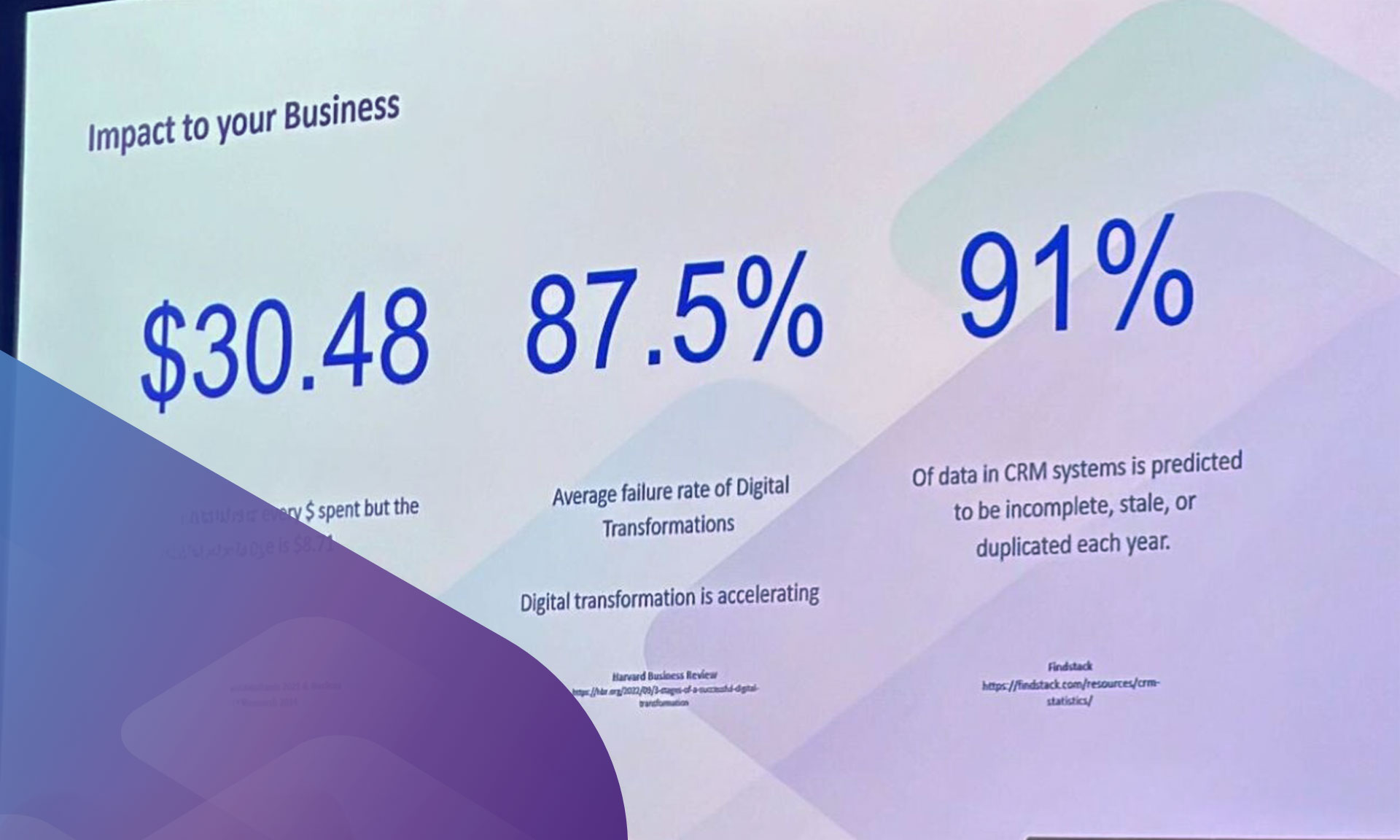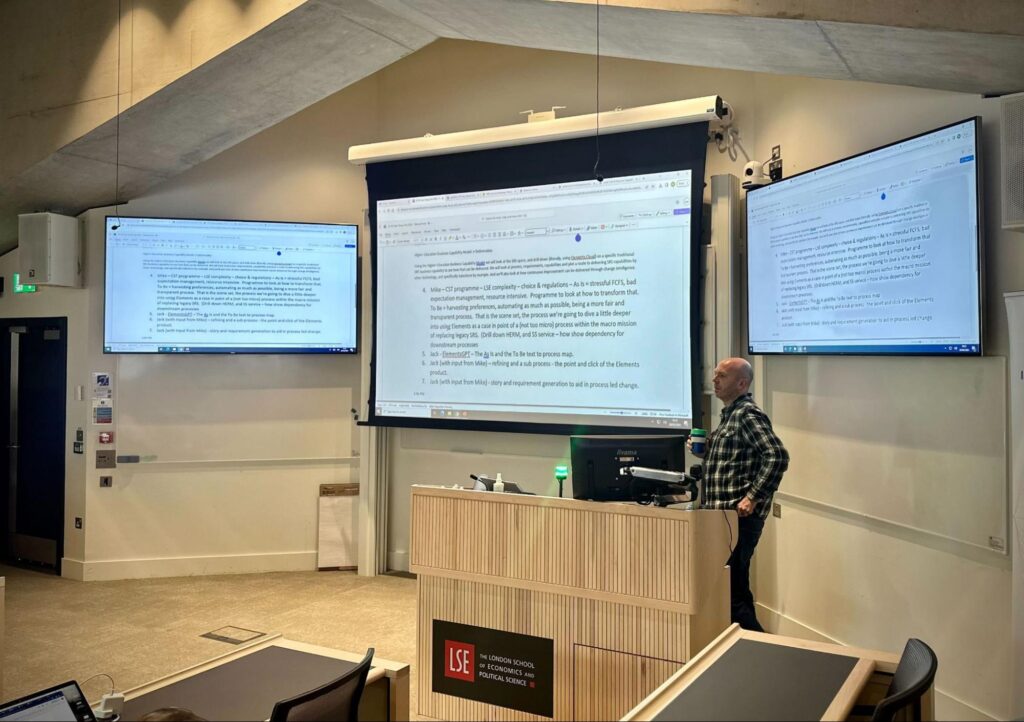
Transforming Salesforce implementations in Higher Ed
Richard Clark, VP EMEA Alliances & Success Elements.cloud LinkedIn
On a clear(ish) day in London, for once without rain, the Elements.cloud EMEA team were invited to join the first of four yearly events, organized by the Higher Education Salesforce User Group. Hosted at the prestigious London School of Economics (LSE) in central London, the group attracts members from the European region and holds events across different cities in the region.
The group, which has been running for over four years, is led by Mike Page from LSE and Rupert Frankum from the University of Plymouth. This particular event, centered around “The (r)evolution to a new SRS as an example of Change Intelligence approaches with Elements.cloud” and focused on a case study of LSE’s journey of migrating away from legacy Student Record Systems providers, to make the Salesforce platform the heart of their student systems.
The event started off with group members enjoying a coffee and pizza networking lunch, to break the ice and allow everyone to introduce themselves. Surveying the room of around 30 attendees, it was interesting to see a wide and equal range of skills from admins through to architects, business stakeholders, independent consultants, and CRM managers.
Diving into digital transformation
After an initial welcome and housekeeping from Mike Page, Toby Hayles from Elements.cloud kicked off proceedings, explaining who Elements.cloud is, and sharing common business problems, that affect all industries. During Toby’s presentation, he noted the appeal of diving into digital transformation projects, tempted by the promise of a potential 30x ROI when using the Salesforce platform. However, with an average of 87.5% of digital transformation projects, failing to meet all of their original intents, and a further 91% of CRM data predicted to be incomplete, stale, or duplicated each year, the risk of unsuccessful digital transformation projects, looms large.
Toby concluded his introduction by explaining the Gartner Pace-Layered model of:
- Systems of Innovation – requiring agile, frequent, and even experimental changes
- Systems of Differentiation – requiring medium changes aligned with competitive goals
- Systems of Record – foundational to the rest of the system architecture and rarely changed.
By applying the Pace-Layered Model, organizations can develop a deeper understanding of the different types of changes that impact their IT landscape. This includes recognizing that systems of record may require more rigorous change management processes to maintain stability, while systems of differentiation and innovation may require more flexible approaches to accommodate rapid changes.
LSE’s journey with Salesforce
Mike Page returned to the podium to present “Who needs Student Records anyway?”. He shared the LSE Technology Strategy map, introducing the group to the CAUDIT (Council of Australasian University Directors of Information Technology) business capability model; a model that LSE shares with UCISA and Educase. Mike explained how LSE’s technology infrastructure aligns with this model, as a strategic guide. He further detailed how Salesforce and other technology platforms are integrated into their enterprise architecture, highlighting current functionalities and potential future capabilities that could be achieved with Salesforce.
Mike highlighted that the new Salesforce Industry Education Cloud could deliver additional benefits to LSE as an institution. At present, they are still assessing where and how quickly they could potentially adopt the additional platform capabilities that Education Cloud provides and its alignment with the subtle differences of the UK higher education landscape.
Elements.cloud in action
As part of LSE’s To Be architecture for Student Administration & Engagement, we saw a live demo from Mike showing how LSE was using Elements.cloud, to define and manage both their business processes and architecture diagrams. Capabilities were delivered through centralized services, with functionality to provide each persona the required view, maintaining the data access and permissions required for each role. Re-use of core generic capabilities tailored to the use case, presented to the user in a unified experience, is key. The experience evolves and improves, as more functions are delivered.
This is not the typical approach to requirements capture. By using both a capability model and an understanding of the supporting systems (through architecture maps,) it’s possible to have a view of how existing systems support the desired outcomes or identify where there are gaps, before rushing to try and force the wrong features into the wrong too. Or, even worse, buy new systems when not needed.
This highlighted the benefit of the Salesforce platform, providing a centralized and secure database of student data. The platform serves different personas in LSE, with a high degree of reuse for each persona’s 360° view, using different user experiences such as Experience Cloud and the Lightning UI. Unlike a traditional Visio diagram, Mike was able to navigate through their architecture, into each persona to track how they had secured access to services and components.
Innovating the course selection process
Mike drilled into the specific area of course module selection, which is a complex process. He highlighted the need to move beyond a ‘first come, first serve’ approach in module selection. This shift is vital to accommodate the needs of the specific students, that have priority module selection over their peers. Factoring in their 1st, 2nd, and subsequent choice picks, alongside whether certain modules can be taken together, quickly complicates the course selection process.
LSE had found that with traditional Student Record Systems (SRS), they had struggled to update the course selection algorithms without code, feeling that they could not implement the To Be process, that they wanted. Salesforce was the natural answer, allowing them to:
- quickly build using declarative tools like Flows
- link Flows to the business processes defined and versioned in Elements.cloud
- have metadata references, connecting the design and implementation.
Process mapping with ElementsGPT
Following an insightful Q&A session, Jack Lavous from Elements.cloud took center stage, to provide an introduction to Universal Process Notation (UPN) and its benefits over traditional process modeling methodologies, like BPEL or BPMN. Jack explained how we could quickly create process maps, following the 5 Ws (What, Why, When, Who, and How) approach.
Jack then introduced ElementsGPT. The demonstration involved taking a Course Instruction text-based requirement from LSE, and generating an initial process map in under 1 minute, using the Elements.cloud integration with the OpenAI API. The intent was not to deliver the whole process faultlessly, but to create a straw man. Unlike traditional workshop methods, where getting access to SME’s and starting from scratch can lead to delays, iteration, conjecture and conflicted requirements for change, this discussion encouraged speedy improvements. In no time at all, updates were made, where processes were parallel activities or exception processes, outside the happy path.
User story generation workshop
Jack also ran a short workshop, to show how Elements.cloud could be used manually, to solve the Student Course Selection problem that Mike had previously described. Jack concluded by generating the same process through ElementsGPT, so that we could compare how a recursive process could be summarized into a reusable child process; like managing the 1st, 2nd, 3rd, and 4th preferences, for example.
Thereafter, Jack demonstrated how user stories can be connected to the Elements.cloud models and even generated automatically from the process maps. Selecting multiple process steps, he created user stories for each selected process activity, using its inputs, outputs, and resource roles to drive the generation.
Higher Education: Reference models and Salesforce discovery
An introduction to reference models helped the group understand how not all data should be represented diagrammatically. Using the Higher Education Reference Model (HERM) from CAUDIT, UCISA and Educase, we saw how the reference model could be used to augment the process maps with contextual information.
Jack wrapped up his demonstration by showcasing Elements.cloud’s advanced Salesforce discovery capabilities. These features aid in managing Salesforce Org technical debt through metadata integration, field usage, and dependency management, offering a clearer understanding of the impact of change. Jack showed how ElementsGPT could even recommend potential solutions for the implementation of the user stories, that had been created.
During the subsequent Q&A session, the group touched on how both Salesforce admins and end users, could access the data and diagrams within Elements.cloud, through the Salesforce Lightning and Setup user experiences. These help guide their usage and provide feedback in turn. Jack received a very positive reaction from the group as we broke for a well-earned coffee break, with many attendees whispering excitedly as they left the room.

LSE’s SRS transformation journey
To introduce the final session of the event, Mike Page returned to the stage to talk about the LSE SRS Transformation history, which started in 2016. He explained how they have iteratively replaced SRS type functionality (Revolution through Evolution), and introduced new functionality across LSE, such as enquiry management.
Mike outlined the different drivers there had been for transformation at LSE, including GDPR and replacing legacy tech. Likewise the Covid-19 pandemic required a greater degree of online processing, remote working, and rapid delivery, including track-and-trace capabilities for the institution.
Different institutions are likely to take different tech transformation journeys depending on the context of the institution, and external forces. As LSE moves into 2024, their focus is on the 360° views for students, academic staff, PSS, and management personas. Additionally, LSE is committed to encourage more teams to adopt Marketing Cloud and CRM, and migrate away from legacy applications. Aided by the introduction of Mulesoft, LSE is stitching more and more together, evolving greater ROI from their platform capabilities to meet their business needs.
Mike closed the day, with thought-provoking commentary on “reversing the flow:’ referencing how in the late 19th century, Chicago countered its issue of sewage waste polluting drinking water. By reversing the flow of the Chicago River, they were able to solve the problem and divert waste via the Mississippi.
This mirrors LSE’s digital transformation journey. Instead of sticking with legacy SRS and solving some problems in Salesforce, LSE ‘reversed the flow.’ The organization made Salesforce the system of process, recording that which has been iteratively replaced over time.
The final word
A group discussion concluded the proceedings. The lively and active discussion covered different institutions’ approach to project governance, product ownership, centers of excellence, and steering groups to break down silos. As thoughtfully shared by one attendee, with an unknown the end state, it was not about Digital Transformation. Instead, it was about creating a culture of Digital Evolution, that could be a constant process.
Many attendees shared similar problems, albeit trying different solutions. With the amount of discussion this topic generated, it seems to be a very worthwhile subject for the next Higher Education User Group to focus on. I’m eager to personally attend the next User Group meeting, to hopefully learn more and share my own experiences from the commercial sectors.
Revisit Mike’s presentation, in which he explores the implementation strategy, challenges and solutions, encountered when he set out to streamline decision-making processes at LSE, to hear more about how Elements.cloud can support digital transformation projects in Higher Ed. Read the complete LSE success story today.
Resources
- Average ROI of CRM is now, estimated to be around $30.48 for every dollar spent – Dynamic Consultant Group
- 91% of data in CRM systems is predicted to be incomplete, stale, or duplicated each year – Findstack
- Rate of digital transformations failing to meet their original objectives, averages at 87.5% – Harvard Business Review
Sign up for
our newsletter
Subscribe to our newsletter to stay up-to-date with cutting-edge industry insights and timely product updates.

Richard Clark
VP EMEA Alliances & Success9 minute read
Published: 1st March 2024






